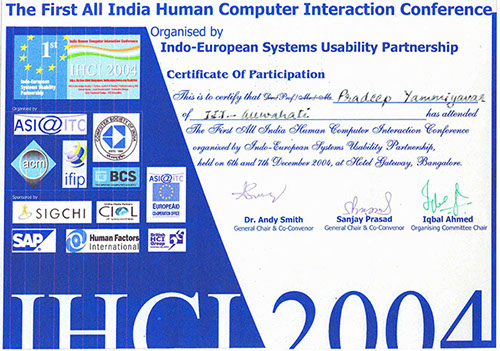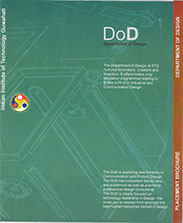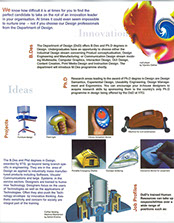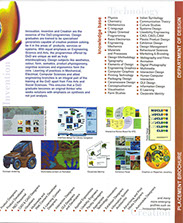Timeline
Historical Timeline Notes
During initial years (1985) in India - Industrial designers and Visual communication designers from the National Institute of Design, Ahmadabad and Industrial Design Centre, IIT Bombay were the main contributors in ergonomics of Interface designing which has now emerged as a separate specialization field of study in Design popularly called as ‘Interaction Design.' In the 1985s and 1990s educational curriculum courses such as ‘Control Panel Design’ [3] and ‘Ergonomics of Electronic Equipments’ [4] offered at Indian Institute of Science, Bangalore, were part of educational curriculum aimed at designing interfaces for industrial, medical, laboratory and electronic equipment. In these courses Design principles for interfaces of physical instruments and electronic products were derived from Ergonomics – Aesthetics and taught in Indian Design schools as part of Industrial or Product Design programs. Industries manufacturing equipment with control interfaces considered equipment interface design as extended part of a product’s engineering design with inputs on layout grids, graphics, and aesthetics made by Industrial Designers. Today this area in Creative Design has emerged as the most sought after specialization rooted in Information Technology (IT) in India.
In the 1990’s as digital multimedia such as video gradually took over traditional printed mediums in Communications, and Advertisements, mechanical knobs, and switches in products were getting replaced by digital technology push buttons and liquid crystal display (LCD) screen interfaces. Need for specialist designers with digital technology skill sets, better knowledge of the consumer needs and systems design thinking ability was felt all around. In response Design schools such as at Indian Institute of Science (IISc – M.Des program), 2002 emphasized the need for training designers in ‘Human Computer Interactions’ by initiating discussions with academics from Europe. In 2003 Indian Institute of Technology Guwahati (IITG) started offering a Usability Engineering stream in Interaction Design within its B.Des program [5, 6, 9, 12,13]. This B.Des program was India' first undergraduate design program with Interaction design as a specialization stream.
Department of Design - IITG Brochure of 2003 announcing Innovation Strategy and Interaction Design as one of the new areas of research. (Click the images to enlarge)
India’s first exclusive Research entity named as ‘Usability Engineering & HCI Laboratory’ (UE-HCI Lab) - dealing with Interaction design, Usability, Interface, User experience design and electronic hardware and software prototyping facility was set up at the Indian Institute of Technology Guwahati in the year 2003 [5, 6, 9,10,12,13]. Ever since IIT Guwahati has produced India’s largest group of over 300 B.Des graduates who have gone on to become Interaction Design leaders worldwide. Some of them have become successful entrepreneurs.
Later on in 2006 other Indian institutions such as Industrial Design Center (IDC) of IIT Bombay [7] and NID [8] started offering Interaction Design postgraduate programs. Today every known IT sector organization, be it multinationals such as IBM, Cognizant, Honeywell, Microsoft, Adobe or India’s homegrown multinational companies like Infosys, Wipro etc including start-ups such as Ola and Makemytrip, Flipkart, Myntra - to name a few - have active ‘Usability’- ‘Human Computer Interaction’ or ‘User Experience’ (UX) design team on their rolls. IIT Guwahati admitted its first Ph.D. research scholar in Interaction - Usability – HCI and started offering courses in 2003 under the broad umbrella of Usability Engineering as part of the B.Des program. The first Ph.D. in Interaction design at IIT Guwahati was granted in 2009 [11]. Over a hundred undergraduates, postgraduates, and PhDs have successfully specialized in the Usability stream, resulting in IITG having a 100% placement record for its HCI Usability - B.Des graduates.
The uniqueness of the IITG experience in HCI education has been its multidisciplinary nature incorporating, Design, Social Sciences, Computer Sciences [5,6,9,10, 12,13]. A large number of Indian students including from IIT Guwahati have also started acquiring Masters and PhDs in HCI from institutions abroad from the year 2005 onwards. However, there is a dearth of dedicated Researchers in this field. Of late new research application areas such as Analytics are demanding Ph.D. qualified professional researchers in Usability. Only two IITs (Guwahati the pioneer in Design Research & IDC –IIT Bombay) have Ph.D. research programs in Interaction Design. The UE-HCI Lab – IIT Guwahati has contributed towards building a legacy for Indian Interaction Designers now recognized worldwide.
International and National Conferences Time-line
Indian Educational Institutions and Corporate sectors have come together to propagate Research output for the benefit of society in the form of hosting and sponsoring events of National and International importance. The first ever Seminar in HCI took place in Indian Institute of Science – CPDM in 2002 with visiting European academics from the United Kingdom. The first pan-Indian conference on HCI, Systems Usability, and User-Centred Design held in Bangalore on December 6 and 7, 2004.[13]. This conference was under the aegis of the Indo-European Systems Usability Partnership (IESUP), in co-operation and association with the Computer Society of India, the British Computer Society / HCI Group, ACM/SIGCHI and International Federation for Information Processing- IFIP.

This was followed by workshops, symposiums, and exchange program held in India in 2005 at the IIT Guwahati under the Cultural Usability project [9,10]. The Danish Science Council with the involvement of the Copenhagen Business School and IITG funded this CULTUSAB project in collaboration with the Usability – HCI – IITG Lab.
One of the main international conferences, HWID 2009, that helped consolidate Research in Interaction Design in India was held during October 2009 in Pune under the Second IFIP WG 13.6 on Human Computer Interactions. It was hosted by CDAC- Centre for Development of Advanced Computing- India and jointly organized by Copenhagen Business School, Aarhus University Denmark and the Indian Institute of Technology Guwahati - India. Springer published proceedings in the form of a Book [14].
Since then more than fifteen international and national conferences have taken place in India within a short span of 5 years, mainly in Mumbai, Bangalore, Hyderabad, Guwahati and Pune. The second IEEE International Conference on Intelligent Human Computer Interaction was held in January 2010 at IIIT, Allahabad. Similarly the Usability Professionals Association, Hyderabad [15] another professional association holds many national events.
India HCI Professional Association is the oldest and largest association for Usability professionals in India. The ‘IndiaHCI’ series of Conferences have been successfully held since 2005 every year under the leadership of IIT Bombay. The most recent one took place at IIT Guwahati in December 2015, and the next one is scheduled to be held in Pune in 2017. [16].
International collaborations like the CULTUSAB project between Copenhagen Business School, IITG and Chinese Academy of Science as well as the IESUP have played a catalytic role for Usability - HCI research activity in India. Similar collaborations are being planned between German institutions and the Computer Science department of IIT Madras, which is setting up a new entity for HCI research. The active collaboration between the corporate sector and Educational Institutions through conferences and events indicates and ensures a very active involvement of professionals in nurturing this youngest specialization in Creative design discipline in India by the year 2016. It all started fourteen years ago in 2002-2003 at IISc Bangalore and UE-HCI Lab at IIT Guwahati.
References for above notes:
1. Jacob Neilsen; Usability Engineering; Morgan Kaufmann, Academic Press. 1993. ISBN 0125184069.
2. Patric W Jordon; An Introduction to Usability; Tylor & Francis. 1998. ISBN 0748407626.
3. P.Yammiyavr; Control Panel Design; Centre for Electronics Design Technology- IISc, Bangalore course publication CBL02, IISc, Bangalore 1992.
4. P. Yammiyavar; Ergonomics for Electronic Equipment Design; Centre for Electronics Design Technology- IISc, Bangalore course publication CBL01. Nov 1992.
5. Pradeep Yammiyavar and Torkil Clemmensen; HCI in Indian ICT Education; ICT4D – Special Issue on ICT Innovation in India; Vol VII, No. 8, Oct-Dec, 2009. Copenhagen Business School. ISSN 0972804X.
6. Pradeep Yammiyavar, HCI and Usability Research in Indian Educational Institutions; in Katre, D. et al.: HWID – Pre-Conference Proceedings –Working Conference on Usability in Social, Cultural and Organizational Contexts, CDAC-IFIP, ISBN 978-81-909383-0-3; Pune 2009.
7. Anirudha Joshi, Interaction Design in India – Past, Present, and Future; CHI 2004, April 24–29, 2004, Vienna, Austria. ACM 1-58113-703-6/04/0004.
8. National Institute of Design postgraduate diploma program. <http://bangalore.nid.edu/academics_dde.html>. Retrieved on 5th November 2009.
9. Pradeep Yammiyavar and Torkil Clemmensen (Editors) Indo – Danish Human – Computer Interaction (HCI) Research Symposium - Cross Cultural Issues in HCI; Proceedings; Indian Institute of Technology Guwahati. 14th and 15th May 2006.
10. Cultural Usability project at Copenhagen Business school - CBS. Retrieved on 2 11-09 from http://www.culturalusability.com.
11. Jyoti Kumar; Comparative Study of Users Experiential Data Collection Techniques for Human-Computer Interaction Design in Cross Cultural settings. Ph.D. Thesis supervised by Pradeep Yammiyavar, Department of Design, Indian Institute of Technology Guwahati. 2009.
12. Pradeep Yammiyavar: Development of an Interdisciplinary curriculum instructional activities and examples from Usability engineering and HCI courses at IITG. Invited Key Note address. HWWE 06; Proceedings; IIT Guwahati, Assam. International Ergonomics Conference HWWE. 05 IITG. 2005.
13. Pradeep Yammiyavar; Incorporating HCI in the curriculum – a case study; CSI Communications; Vol. 29, September 2005 No 3. Computer Society of India.
14. Dinesh Katre, Rikke Orngreen, Pradeep Yammiyavar, Torkil Clemmensen ( Eds); Human Work Interaction Design: Usability in Social, Cultural and Organizational Contexts. IFIP Advances in Information and Communication Technology. Springer. 2010. ISBN 10 3642117619.
15. Usability Professional’s Association, Hyderabad; http://www.upahyderabad.org retrieved in 2009.
16. India HCI Series of Conferences. www.indiahci.in. HCI Professional Association of India registered. Retrieved June 2016.
< Back Profiles of Faculty In-Charge >




-min188x224.jpg)
